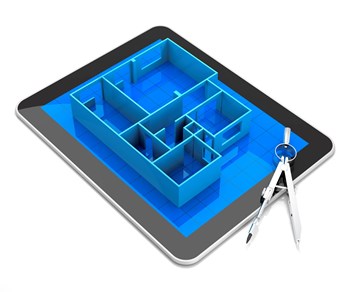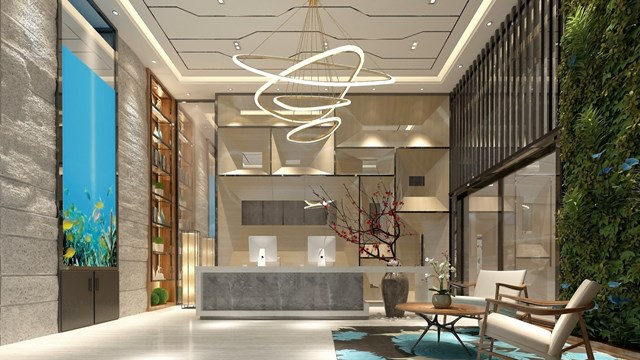
In the past, when it came time to do a remodeling project, no one really ever had much of an idea as to how things would turn out. Architects and designers would come by with blueprints or swatches of color and fabric and ask you to just imagine how it would look when finally complete.
They’d try to explain their vision as you stood there in the room as it was, trying to see it as it could be. Your eyes would move from the swatch of color or the flat blueprint that you had no idea how to read, then to the rest of the room, and then back.
Just imagine, they would say. Their faces lit up by expectation, excitement, that you would see what they saw and be amazed with the possibilities. You’d nod your head, probably unable to see what they saw, and agree anyway—never entirely sure that their vision of what could be matched up with your own.
That’s just how things were, but time moves and things change. Now you can see, with your own eyes, how things will look in the end. To know in advance that you’re getting exactly the design you wanted. The process of design has taken quantum leaps from those days and while it isn’t always feasible to use the latest techniques or technologies, these days you can see what you’re getting before any of the changes even begin.
Seeing is Believing
“Remodeling projects can be some of the most complex projects; if they are not managed properly they can wind up as a huge disaster,” says Oleksii Klymenko, the founder of Vanguard Development in New York City, a firm that does design work across the world.
Klymenko explains that his firm gets rid of a lot of the complexity by streamlining the process and they do that by making sure every part of the design in nailed down before the work even begins. His firm does this by creating a series of true to life images, almost indistinguishable from actual photographs, of whatever project they are working on.
“In creating the mockup the client will get an estimate of how much the materials and finishing will cost, but not the actual construction,” says Klymenko.
They create these mockups through the use of 3D Max, the same program Dreamworks used to create Shrek. He explains that it takes more than just the program to do the job; that they have to start with a series of accurate measurements and use a number of filters to get the results they are looking for. In doing this they create not only one image showing what the final design will look like, but a number of them.
“We give them at least four options per room, each one very different but within their chosen style. Our goal is to develop five or six decent options from them to choose from and step back,” says Klymenko.
Klymenko explains that they look to create a feeling that you can actually imagine yourself in the room, he says by making these hyper accurate pictures they’re able to nail down exactly what the client wants.
He goes on to say that it’s not only the ability to make the pictures themselves that help keep down the costs, but their catalog of furnishings to choose from.
“We carry a library that consists of 5,000 items that can be sold in this country, so once we design and present something to the client we know how much it will cost,” says Klymenko.
So if a client likes a particular design, but wants to save some extra money Klymenko says they can, “redevelop some images, give you some options and there can be another bed that will be the same black tufted bed that costs $2,000 instead of $10,000. We’ll give you an alternative image to show you if you are ready to compromise with this bed and save $8,000. So we still use these images to go through small adjustments.”
The idea being that if everything is decided beforehand, that there will be no surprises and costs will be kept down.
Virtual Reality and Technology
It doesn’t stop at just hyper realistic pictures, with advancements in virtual reality technologies--those headsets everyone’s talking about—it’s now possible for someone to take a walk through a completed room or building before construction even starts.
“We can present the future state of a property based off of floorplans, blueprints and architectural documents,” says Jeff Maurer, the founder and CEO of Virtual Xperience, (VX), a firm located in New York City, that creates virtual reality tours for real estate offices as well as architectural and design firms.
Since VR headsets, like oculus rift, are not yet widespread this particular part of their service is only available at the offices of their clients and not at people’s homes. That doesn’t prevent someone from viewing the virtual tour from their home computer, they can be uploaded to an association’s website for home viewing, but unless you’ve got your own VR headset you won’t get the full experience.
“It’s the same product used in different ways and it all depends on the customer’s needs,” says Maurer, “If you have a co-op that’s putting in a new lobby or recreation facility on an upper floor or redesign the laundry room and storage area and they want to have people have access to plans it’s a great product to have so people can interact with the content. It could be part of the approval or buy-in process.”
By making these videos available to an association, a board could easily get feedback on a proposed design without needing an architect to walk everyone through what the finished product would look like. Any changes, from a new wall color and a removed wall to an entirely new room, could potentially be viewed in their completed state before construction even starts.
“It puts everyone on the same page so that they can truly understand and experience the changes that will be coming,” says Maurer.
It would also allow prospective shareholders and unit owners to view their units without even entering the building itself. So if there are extensive renovations going on, such as combining two units to then be rented out or bought, the board could make such a video available to allow prospective shareholders to take a tour of where they’re thinking about living without having to explain what the finished unit will look like. They’ll be able to see the finished state from the start.
“What we do is start with a blank, black universe and create every floor, every wall, every texture, every furnishing. It’s like a high quality, photo realistic video game, where you can walk through and truly experience the space,” says Maurer.
So they’re able to take established techniques and technologies, apply their own spin as well as the latest technologies, to create a new experience without needing to reinvent the wheel.
Physical Advancements
Visualizations isn’t the only place design has advanced with the times. According to Jonathan Baron, ASID, president of Baron Design Inc., and a New York State certified and licensed interior designer, “Different products have become available due to advances in technology.”
The advancements have come from surprising places. Perhaps the most unexpected of which has been the space program. The space shuttles had been covered in heat resistant porcelain tiles, to allow the shuttle to survive the massive heat of reentry, which has resulted in the advancement of domestic tile production.
“One you might not think of is porcelain tile. The advances of digital technology have led to improvements in porcelain, a result of space travel. We’re not talking about tile for your bathroom. They have panels of tile that are a ¼ inch thin, that are printed to look like stone. So in a lobby that you would find stone tile or slabs, you’re now able to find, at a fraction of the cost, porcelain tile that looks like stone slabs. There’s also tile that looks like limestone or marble for the floors,” says Baron.
So if you were to want a marble floor of the lobby of your co-op or condo building you could get the look of a marble floor for a fraction of the actual cost due to the advancements made in the area of porcelain tiles.
“There’s also a company producing carpets that have the look of a woven axeminster carpets that are actually made of wool. They’re able to weave the carpet out of nylon,” says Baron, but it’s not just materials that have advanced. It’s also building services.
“I have heard about facial recognition intercom systems. So instead of having a fob or a keypad, the camera recognizes the faces so you can put a picture of the people you want to let in, so you could put in a photo of someone and they’ll be able to get inside without needing to be buzzed in,” says Baron.
Something like this would allow for unit owners to just allow their friends and family to come up and visit them at any time without needing to worry about constantly buzzing them in. There are those however who feel that the technology has not yet hit primetime, there have been reports of accuracy issues here and there, but there are also those who swear by the systems. So like with every new technology, there may be some bugs to work out.
John Zurz is a staff writer for The Cooperator and other publications.






Leave a Comment